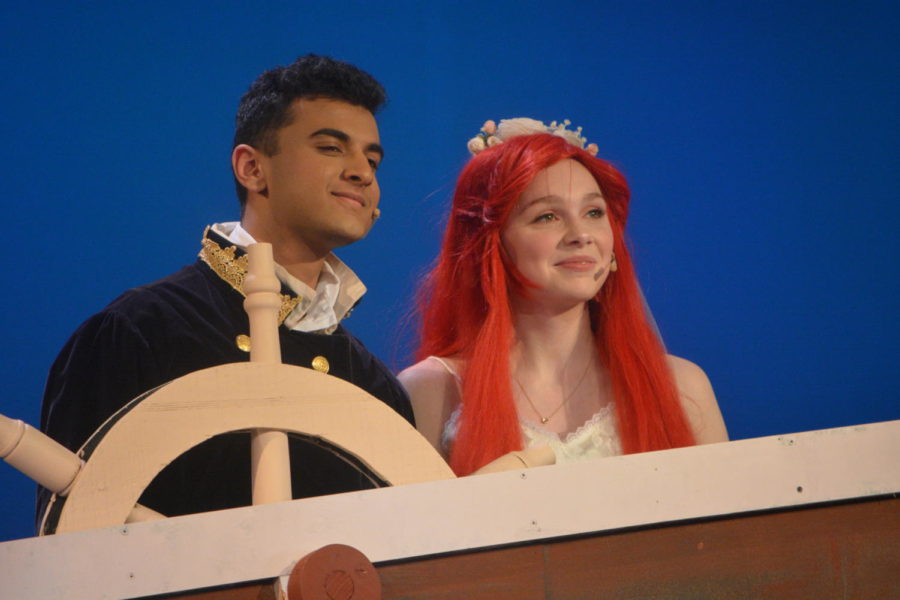The Little Mermaid cast makes a splash in spring musical
Up to no good- Ursula, played by senior Camille Hoheb, sings “Poor Unfortunate Souls” as she tries to convince Ariel, played by senior Quinn Mahoney, to give up her voice in exchange for the chance to be a human. The Drama Department showcased The Little Mermaid on March 7, 8 and 9 to crowded audiences.
March 8, 2019
For three nights in March, the Drama Department staged productions of the Disney musical The Little Mermaid. The Little Mermaid is based on Disney’s 1989 film of the same name, which itself was derived from a story by Danish writer Hans Christian Andersen. The film marked the beginning of the so-called Disney Renaissance, a period where the studio released numerous movies that have become widely beloved, and was adapted into a broadway musical that was first performed in 2007.
The musical follows Ariel who is played by senior Quinn Mahoney. A mermaid fascinated by the human world, she falls in love with the human Prince Eric who is portrayed by senior Yash Sabarad whom she rescued from drowning. However, Ariel knows her father King Triton, played by junior Ben Cooley, would never permit the relationship, so she sneaks off to strike a deal with her villainous aunt Ursula who is played by senior Camille Hoheb. Ursula agrees to make Ariel a human in exchange for her voice. As another condition, Ariel must kiss Prince Eric within three days otherwise her soul would forever belong to her evil aunt. In her progression as a character, Ariel learns how deeply her father cares for her and ultimately defeats Ursula. The musical ends happily with the wedding between her and Prince Eric.
According to Director of the musical Katie Seymour, the cast first read through the musical in December. Leading up to the musical, rehearsals occurred on a nearly daily basis during the school week, and some even took place on Saturdays. During this preparation process, the cast and crew worked to bring their musical to life.
Sabarad said that his role as Prince Eric presented new challenges for him as an actor.
“Eric is different from my other roles in stage presence. I’ve never played anything remotely close to a lead, and this time I really had to step up my game in terms of memorizing my lines, show emotion, and connect to the audience,” Sabarad said.
Hoheb prepared for her role as Ursula by watching the Disney film and shows featuring Divine, a drag queen on whom the character of Ursula was based. She also filmed herself performing and analyzed the footage in order to improve.
“Something that is really difficult for many actors is learning from others without copying. There are tons of videos of other people’s versions of Ursula, but to gain inspiration and still create your own character can be really difficult,” Hoheb said.
Senior Grace Duncan choreographed the musical, drawing upon her experience as a competitive dancer. According to Duncan, she sought to create choreography that “fit the tone of the music and the story.” Duncan says that she has enjoyed being the choreographer and hopes to continue being involved in theater after graduating high school.
Art teacher and set designer Andrew Minor designed the sets “to be true to the Disney ‘vibe.’” Minor derived inspiration from a production of The Little Mermaid at the Warner Theater in Torrington and other high school productions. Rather than relying on skates or harnesses, Minor used set design to convey the differences between land or in water.
Applied Arts teachers Jeff Teravainen’s construction and James Corrigan’s 3D design classes helped to build the sets, and Minor found ways to reuse parts from sets of previous productions like The Crucible, Beauty and the Beast, and Little Shop of Horrors in order to conserve costs.
Music teacher Shannon Prouty directed the pit orchestra, which consisted of eight adult musicians and four students. According to Prouty, a pit orchestra director performs three roles: “conducting the instrumentalists, cuing the actors to start their songs, and knowing the dialogue of the show.”
“If anything went wrong on stage, I needed to be able to ‘catch’ the singers and actors where they are, making split-second decisions about what music to skip or repeat with the pit orchestra. There is no such thing as ‘starting over’ in a live performance,” Prouty said.
Assistant Director Vanessa Clarke valued collaborative effort between the drama, music, applied {and fine arts, and audio visual departments in staging the musical.



